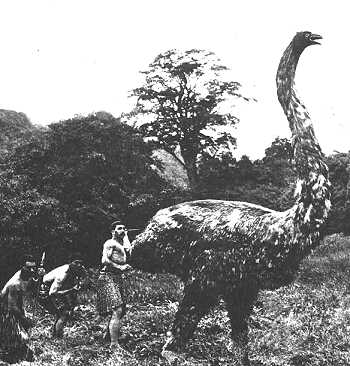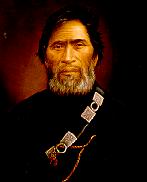Maori did more than survive - they adapted to their new world almost instantly, and built a complex artistic and sophisticated society in only a few centuries.

There are three periods of the Maori history within New Zealand:
Colonial
Transitional
Tribal
The first colonial period is also known as the Moa Hunter period (image above). This large flightless bird, along with flightless goose, adzebill, swans and pelicans were hunted to extinction within 100 years. Sealion and elephant seals were also decimated - conservation of food resources was a bitter lesson soon learnt.
The comparatively large landmass of New Zealand was a ripe paradise, from the very cold reagions of the lower South Island to the sun-baked reaches of the upper North, for the new arrivals, and they spread quickly through the country establishing and consolidating their presence.
The colonial period gave way, as the plentiful food resources dissapeared, into the transitional period where Maori learnt the skills of gardening, seafood gatehring and snaring for small game. The roaming, hunting phase had led to area-consolidation through the 14th and 15th century.
The transitional period is also distinguished by an evolution of the art that now moved away from it's Polynesian roots to become unique - and a more settled lifestyle that focused on local resources.
The ocean-going canoes were no longer a primary purpose - cultivation of food and it's preservation had replaced the explorative and roving lifestyle.
This led inevitably to the establishment of fortified settlements - growing crops and stored food had to be protected.
The groups of Maori who were now settling into regions also became more focused and organised as unique sub-tribes of the original canoes, and were claiming territory.
Michael King commented, "the cultural focus shifted steadily away from .. origin to a singular awareness of and commitment to the adopted homeland"
In other words, Maori had divided and become individuated as unique tribal groups.
The tribal era that had emerged by the 16th century established two pre-occupations apart from the maintenance of life: that of competition with other tribes ( iwi ), and with prestige ( mana ).
Territory was always at stake - it needed protecting, and mana was the honour with which perceived wrongs were righted.

This
Web Directory will always be dynamic ~
all details are flexible and changing